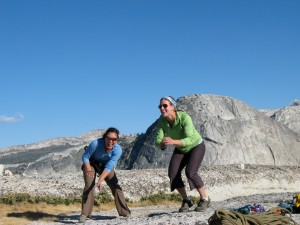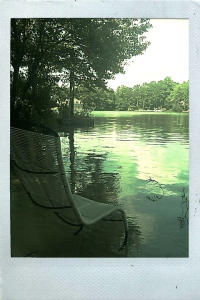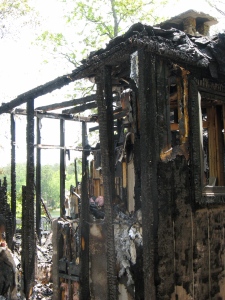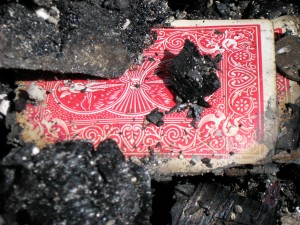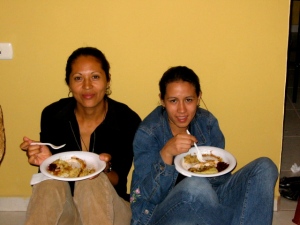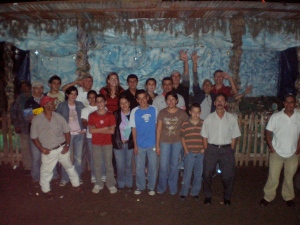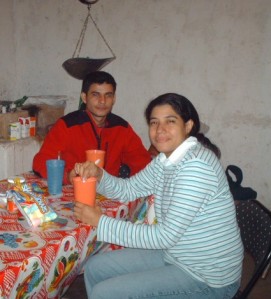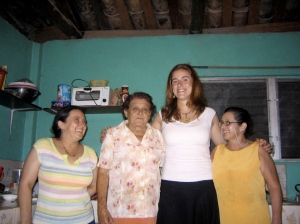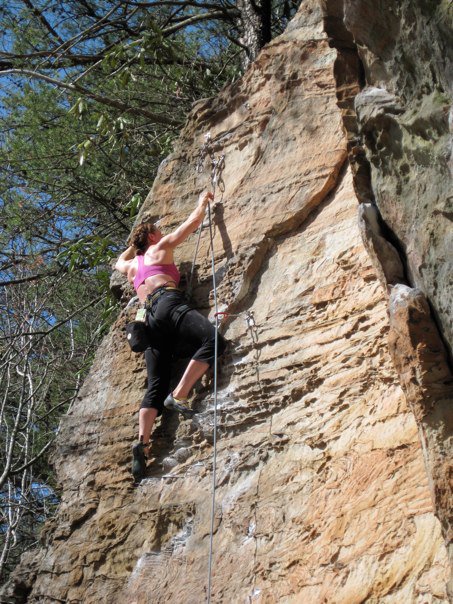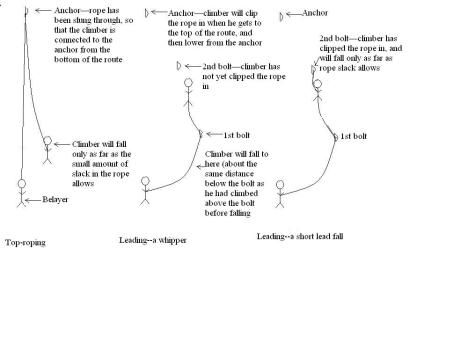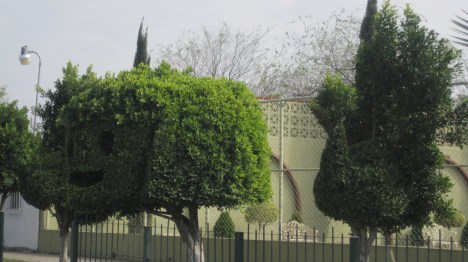I cheese-gratered on a #1 C3 the other day, and it held my fall. That is to say: I skidded 20 feet down a lichen-speckled granite slab, 700 feet above the ground. A half-inch aluminum camming device that I had stuck inside a flake of rock caught me. When I peeled off my lycra climbing top to change into pajamas that night, my legs felt a dusting of coarse, gritty lichen dust.
The thing with trad climbing is that there is not always a set route. It’s not like leading sport, where you follow the bolt line and hope you can figure out the moves intended by whoever bolted the route[1]. With trad climbing, you choose your own adventure, based on the moves you imagine on the rock features before you. It’s kind of awesome.
Except when it’s not. Sometimes, it’s hard to read the rock. Part of learning to lead trad is learning to look around and examine possibilities before charging forward. Some of us have to learn this the cheese-grater way.
I was standing on a huge ledge, 4 pitches up, on what was supposed to be either a 5.5[2] or 4th class[3] finish to a 5-pitch[4], 5.9, 5-star route in Yosemite’s Tuolomne Meadows. I had made it past the “slick face moves[5],” “intimidating roof[6],” and “run-out offwidth[7]” that I had been warned about, and I had flowed through the sustained finger crack[8] that I was definitely not expecting (Ahhem…Voltaire!…Where was the beta on that little gem?!).
The short version of the story is that I let my guard down. I looked to the right and saw some flakes and bulges that blocked my view of what was above. I knew that to my left was the “4th class” option, but I didn’t want to wuss out. Directly above me the rock looked like featureless, unprotectable, but low-angle slab, and I knew that something around here was supposed to be 5.5. Often features appear on a slab when you least expect them, so I pulled myself up on the only two knobs I saw and flagged my right toe out for balance.
After I had pulled a few moves, it looked unlikely that features were going to appear. There was one tiny flake to my right that I could barely reach; it * sort of * had space for my smallest cam, so I jammed it in. My toes were threatening to lose their grip on the eighth-inch edges that they were balancing on; I found some equally tiny edges to fit my fingernails behind and pulled up again, sticking my butt out to maximize surface contact between the wall and my sticky rubber shoe soles. I noticed myself taking quick, shallow breaths as I lost traction on the flaky lichen. Since there was nothing for it but to keep moving, I clawed my way towards a shallow hollow, on which I hoped to mantel and throw my left foot up.
After 600 feet of climbing and 20 feet of clawing, I wasn’t as ready for push-ups as I might have liked. My triceps gave out at about 60 degrees and I found myself skidding down the slab. My chin bounced, and my fingers desperately grazed for something to catch. I don’t think I made any noise on the way down, other than the scraping of skin and fabric on the rock. My friend Genie says it was like watching a slow-motion movie.
The good news is, that tiny red cam caught my fall. Even if it hadn’t, I was only 20 feet above the belay, where Genie was connected to a bomber anchor. Thanks, Mr. Long. I landed on a wobbly boulder and looked quizzically at Genie, wondering how it was possible that I had cheese-gratered on the easiest pitch of the route.
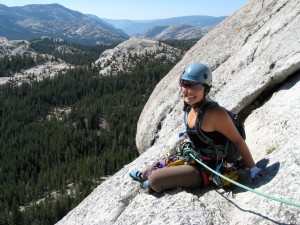
The other good news is that we had made friends with a couple of med students, Nate and Carl, who were climbing behind us. Carl was leading the pitch below Genie and appeared below her just after I landed. We told him he’d missed the excitement, and he assured us that medical attention would be available on the summit.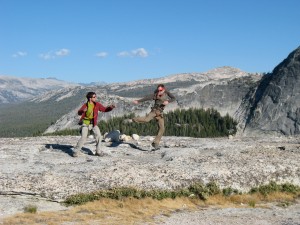
I shook my head at my perforated right arm, pinched my pants off of my gooey left knee, chose the 4th class traverse left, and learned quite a bit about rope drag[9].
Nate and Carl finished the route just as Genie pulled her last move, and they bounded over to where I was awkwardly heaving the rope through my ATC. The four of us chatted on the summit for about an hour, eating peanut butter and banana sandwiches, avocado and tortillas, salami and cheese, and trail mix. We pondered how an enormous erratic boulder had come to be perched on the edge of the dome and argued about whether we would use it as an anchor. We took jumping photos of ourselves before the backdrop of Fairview Dome, atop which I took my favorite jumping photo ever, last summer.


Eventually, we tied our ropes together and rapelled down the dome, sent Nate and Carl down into Yosemite Valley to be awed, and all camped together that evening.
The next morning, Genie and I awoke early to brave the crowds on another Tuolomne classic, Cathedral Peak, which I blame for addicting me irrevocably to rock climbing.  Last year, I followed my friends Voltaire and Pam up Cathedral, cleaning Volt’s gear placements and relishing the climb’s variety of features and movements. This year, I led Genie up it, *avoiding lichen* and trying to flow with the rock to create a safe, fun route. As I pulled the final moves, I hoped that Genie would be as stunned as I had been by the panorama. Despite the chilly wind and the persnickety crowd, Genie’s eyes widened a bit after she gained her footing at the summit. Gazing across Tuolomne Meadows into Yosemite Valley, with Half Dome looming below us in sunset’s haze, Genie and I wondered again: some people die without ever seeing this!
Last year, I followed my friends Voltaire and Pam up Cathedral, cleaning Volt’s gear placements and relishing the climb’s variety of features and movements. This year, I led Genie up it, *avoiding lichen* and trying to flow with the rock to create a safe, fun route. As I pulled the final moves, I hoped that Genie would be as stunned as I had been by the panorama. Despite the chilly wind and the persnickety crowd, Genie’s eyes widened a bit after she gained her footing at the summit. Gazing across Tuolomne Meadows into Yosemite Valley, with Half Dome looming below us in sunset’s haze, Genie and I wondered again: some people die without ever seeing this!
Six months ago, I didn’t think I would be leading trad anytime soon. 6 days ago, I didn’t think I’d be in Yosemite this summer. Now, I am severely distressed about what I’m going to do in Michigan, where there are no mountains.
[1] “Trad climbing:” Traditional climbing, which is rock climbing without permanent protection. The leader carries camming devices and chocks used to wedge into cracks in the rock and clip the rope to catch a fall. The follower cleans these pieces of protection on the way up. “Sport climbing:” climbing on rock into which someone has drilled bolts and attached hangers. The lead climber follows the line of bolts, clips quickdraws into the hangers and attaches the rope to the quickdraws, to catch a fall. Enter again the stick figures, in case you missed them the first time.
[2] 5.5 is a difficulty rating in rock climbing. The first “5” indicates that this is, more or less, a vertical wall. The number after the decimal point indicates the relative difficulty of the route. The higher the number, the more difficult the route. 5.5 is easy climbing.
[3] 4th class is scrambling that is easier than 5.0. It is considered easy enough that a climber doesn’t * really * need the protection of a rope.
[4] A pitch is essentially a rope length in climbing. If a climb is longer than a rope can reach, it is necessary to set up an intermediate anchor and belay somewhere in the middle, so that the leader and belayer can leap-frog up the cliff. This climb was five pitches long, so we set up four intermediate anchor/belays to reach the summit.
[5] “Slick face moves” or, slab climbing: balance-intensive climbing on rock with only a few thin features to hold onto or step onto.
[6] A “roof” is just what it seems like it would be: a horizontal protrusion in an otherwise vertical face that the climber must pull around and above.
[7] “Runout” refers to a section with long distances between opportunities to place protection. If there are 20 feet or more between points of protection, I consider the climb a bit runout. There were 40-foot spans between pieces of pro on this route. “Offwidth” refers to a crack that is too wide to jam a fist or foot into, but too narrow to squeeze your whole body into. Offwidths are notoriously awkward.
[8] A finger crack is also just what it sounds like: a crack in the rock that you climb by jamming your fingers and toes into it. For most of this crack, both sets of fingers and toes were jammed into the crack as I moved up the wall. Crack climbing requires a unique combination of balance and technique.
[9] Rope drag is the term for the friction created by the rope dragging across the rock as the leader climbs a route. A traversing or zig-zagging route can create serious rope drag, pulling down on the leader and threatening to peel her off the rock. It’s quite nerve-wracking to climb against the friction of your own route.
Filed under: Uncategorized | 5 Comments »



